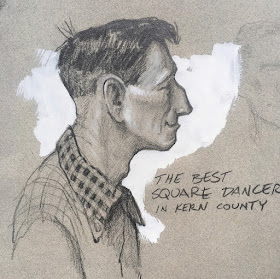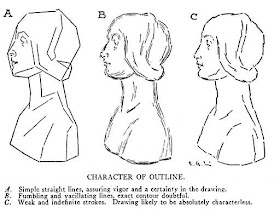Saturday, July 31, 2021
Yuri Volkov's Painted Studies
Friday, July 30, 2021
Tex, Square Dancer
Thursday, July 29, 2021
Sensor Fusion Problem
Light enters our retinas, and the optic nerve feeds information back to the visual cortex. After that, the signal follows neural pathways to various areas scattered throughout the brain.
For example, the dorsal stream interprets movement, while the ventral stream decodes information about shape, color and object recognitions.
In addition to the visual streams, other streams of sensory information arrive via sound and touch. Those signal pathways also appear distributed around the brain.
For a long time, neuroscientists supposed that all the various streams of sensory impulses must converge or fuse together at a central location, but it doesn't happen that way.
Given the scattered nature of that neuronal activity, how is it that we feel that our perception is a single experience?
According to neuroscientist Jeff Hawley's new conceptual model of the brain, the various areas in the cortex arrive at a preliminary conclusion of what they're looking at. They appear to form a consensus in a manner very much like voting. To do that they don't need to be in the same place.
A Thousand Brains: A New Theory of Intelligence by Jeff Hawkins
NOTE: If you get my blog posts by email, you should know that Google is taking away email subscriptions next month. I'm trying to figure out a way to replace Feedburner for getting you your daily feed. Otherwise, you'll just have to click over to the blog to see new posts.
Wednesday, July 28, 2021
How to Begin a Drawing
NOTE: If you get my blog posts by email, I'll need to set up a new mechanism, because Google is taking away email subscriptions next month. I'll send you a special email sometime next month to let you know where to subscribe if you want to continue receiving a daily feed.
Which of the following is the best way to start a drawing?
A. Simple straight lines. B. Sketchy lines leaving the exact contour unclear, and C. Short, indefinite strokes.
In his 1916 book Practical Drawing, E.G. Lutz suggested that students should follow the first method. The other two lead to "vacillating" and "characterless" results.Once the drawing is accurately established, the next task is to begin shading. Lutz discusses the following methods:
I have copies of Practical Drawing plus Drawing Made Easy in my web store, and would be happy to sign them for you or a young artist you're encouraging.
NOTE: If you get my blog posts by email, I'll need to set up a new mechanism, because Google is taking away email subscriptions next month. I'll send you a special email sometime next month to let you know where to subscribe if you want to continue receiving a daily feed.
Tuesday, July 27, 2021
Gold Bust of Almestra

--
From Dinotopia: The World Beneath, signed copies available at this link, and you can also get it on Amazon.Monday, July 26, 2021
When Did the Golden Age End?
"How and when did the "Golden Age of Illustration" end? Did it end, or just shrink? Has there been a revival? Do you have thoughts on this, as an illustrator working with traditional media, in an imaginative realist genre, in the 21st century. How do artists now, relate to a golden age of illustration that supposedly ended? I would prefer to offer a hopeful analysis!"
My answer: A lot of illustrators who lived through the Golden Age years (from 1890-1920) complained that the great era of story illustration ended as the 1920s settled in, as a result of advertising, photographic illustrations, and other distractions such as radio, movies, and later TV.
But if you look at magazines from the late '40s and early '50s, they were bursting with great illustrations, in creative layouts and strong storytelling.
When I started doing book covers and Nat Geo illustrations in the early 1980s, it sure felt like the Golden Age was still alive in my little corner of the profession. I didn't pay much attention to the famous illustrators that were popular in my time, but instead I oriented to Rockwell, Loomis, and Pyle and built my reality around their ideas. The art directors I was working with were giving me a lot of freedom, and there was a small but loyal fan base.
But there was no doubt that illustration has been far less mainstream for the last half century than it was in the days of Pyle, Wyeth, Rockwell, Leyendecker, and the illustrators of the "slicks." That difference is reflected in the fees illustrators receive. For instance, Charles Gibson was regarded like a movie star. The pay he would receive for a single pen and ink drawing would be equivalent to about $45,000 today.
Sunday, July 25, 2021
Using "By James Gurney" as a Style Prompt


Saturday, July 24, 2021
If you don't have much time, skip the pencil and draw with a brush
The #6 round brush I start with is by Richeson / Quiller
Friday, July 23, 2021
Ask your question about on-location sketching
Hi, I'm gathering recorded questions to answer in a future YouTube video about Painting or Drawing on Location.
The widget above lets you record a question on audio and send it to me. Please think about your question (keep it very brief) and give it a try. Be sure to include a name (real or made up). You get to review your question before it is sent. I may not get to all of the questions, but I'll try.
Thursday, July 22, 2021
Reflections in Shallow Water

Wednesday, July 21, 2021
Gouache Seascape by Trost Richards
Tuesday, July 20, 2021
Pyrocumulonimbus Clouds
New York Times: "How Bad Is the Bootleg Fire? It’s Generating Its Own Weather."
Monday, July 19, 2021
Fog in the Harbor

The water in this Maine harbor is glassy smooth, just one tone darker than the sky. Everything is gray except the red details at the waterline. All the color and detail of the far boats drops out. The distant sailboat is just a ghost.
Sunday, July 18, 2021
"Make every stroke count"
Saturday, July 17, 2021
Belt-Driven Drill Press
Bonny Hartigan: "My dad had a woodworking business and when I was a child, most machines were belt driven with water power. It was so quiet compared with the electric motors that he had later. All you heard were the whirring and slapping of the belts. What a wonderful memory that is, thank you for reminding me."
DK Vosburgh: "The sad thing is that most of these old machines fell out of use when their babbitt-metal bearings wore out, and people had forgotten how to cast new ones. They worked fine, otherwise."
Ken Simpson: "When [I was] a young fellow working in hardware store we sold the flat belts and joiners, the 2” belt was sold to the local school to make hand straps to punish boys in fractions."
Friday, July 16, 2021
How William Morris Printed His Wallpaper
Experts at the Victoria and Albert Museum have reconstructed the methods used by William Morris to print his wallpaper.
William Morris, Wallpaper, Acanthus Design
They're using the same original hand-cut wood blocks that Morris used, with as many as 30 different blocks and 15 different colors for each design.
Here's the link to the video on Victoria and Albert channel.
Read More Online:
HOW NATURAL GREENS INSPIRED THE WALLPAPERS OF WILLIAM MORRIS (Elle)
Thursday, July 15, 2021
Video of Ernest Watson
Ernest Watson wrote many instructional books and was an advocate of pencil sketching. I didn't realize it, but he also produced instructional videos.
His grandson put this one on YouTube recently. He also shared this bio info:
"Ernest W. Watson was born in 1884, graduated form Massachusetts Normal Art School in 1906, and received an Art Teacher Education Degree from Pratt Institute in 1907, where he subsequently taught from 1908 to1929. He co-founded the Berkshire Summer School of Art in Monterey, MA, with Raymond P. Ensign, was art editor of Scholastic Magazine from 1931 to 1937, when he founded Watson-Guptill Publications along with Arthur L. Guptill and Ralph Reinhold. Watson was vice-president of Watson-Guptill, and Editor in Chief of it's publication, American Artist Magazine, until his retirement in 1955. He died in 1969. He is best known for his broadstroke pencil drawings, an example of which is demonstrated in this film, and for his linoleum block prints which he often co-created with my grandmother, Eva Watson."
Wednesday, July 14, 2021
Vassar Library and Dinotopia
When Life Magazine put together a story about the origins of Dinotopia, we brought together several of the models, including publisher Ian Ballantine (who posed for Nallab the librarian), and editor Betty Ballantine (on the balcony, who was Norah of Treetown).
Tuesday, July 13, 2021
Fashion Illustrations of Constance Wibaut
Her drawings are spare and direct, with bold colors, clear shapes, and strong silhouettes.
"The need to be precise and to include all the details, from the buttons to the stitchings – as they were important for sales – would have influenced her future illustrations, which were characterized by elegance and easy legibility."
More in the book 100 Years of Fashion Illustration











































